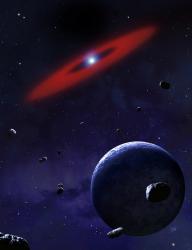 Astronomers have discovered a ring of metal-rich gas surrounding a relatively nearby white dwarf star that gives us a glimpse at the future of our own Solar System.
Astronomers have discovered a ring of metal-rich gas surrounding a relatively nearby white dwarf star that gives us a glimpse at the future of our own Solar System.
The white dwarf has the memorable name SDSS1228+1040, and it’s located about 463 light years away in the constellation Virgo. Astronomers think the star was once a main sequence star like our own Sun, but then it ended that phase of its life and became a white dwarf about 100 million years ago.
Observers from the University of Warwick were analyzing the light from the star, and discovered that that it had additional metals superimposed over top of it. This means that there are large quantities of iron, magnesium and calcium located in a ring around the star, extending out about 1.2 solar radii, or 800,000 km (500,000 miles).
It’s believed that a fairly large object, like an asteroid, strayed to close to the the star and was torn apart by the powerful gravitational tides. The ring of rubble was then evaporated by radiation from the white dwarf.
This scenario gives an example of what our Solar System might look like 5 to 8 billion years from now, after our own Sun runs out of fuel, expands as a red giant, and then collapses down to a white dwarf. Having consumed the inner planets in its initial expansion, it’ll then snack on asteroids for billions of years after that.
